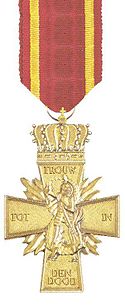- Dutch Cross of Resistance
-
Dutch Cross of Resistance 
The Dutch Cross of ResistanceAwarded by  Kingdom of the Netherlands
Kingdom of the NetherlandsType Civil decoration Awarded for For extreme bravery awarded to the Dutch Resistance Status Not awarded anymore Statistics Established 3 May 1946 Total awarded 95 times Posthumous
awards93 times Distinct
recipientsGerard Tieman (only living recipient) Precedence Next (higher) Honorary Sabre Next (lower) Honorary Medal for Charitable Assistance 
Ribbon bar of the Dutch Cross of ResistanceThe Verzetskruis 1940–1945 (English: Cross of Resistance 1940–1945) is one of the highest possible decorations that exist within the Kingdom of the Netherlands.
When the Netherlands were liberated in May 1945, the Dutch government in London had succeeded in developing a good and balanced system of both military and civilian decorations. Apart from the already existing Military Order of William, new decorations aroused like the Bronze Lion, the Bronze Cross, the Cross of Merit and the Flyers Cross. Deeds of courage could be awarded in a very efficient way. However there was not a good decoration to award people of the resistance organisations. In surrounding countries the governments had already succeeded in filling this gap. The Dutch government also tried to achieve this goal. Because there could not be found an agreement whether deeds of resistance could be awarded with an existing Military decoration or there was to be developed a special decoration, time passed on.
Especially within the Dutch Resistance there was a forceful movement against the decoration of resistance deeds. During war, every deed of resistance was thought to be equal to any other. However, other countries did decorate Dutch resistance people. A significant number of Dutch people were awarded decorations like the British King’s Medal for Courage in the Cause of Freedom and the American Medal of Freedom for their resistance work. Strengthened by this the Dutch government pushed on. Apart from that it was a personal wish of Queen Wilhelmina of the Netherlands that resistance work should be decorated.
By Royal Decree of 3 May 1946 the Resistance Cross was instituted. The formal disruption was: The Bronze decoration of the Resistance Cross resembled a four armed cross, imbedded on a star of flames and covered with the Royal Crown. On the front one can find Saint George (the Dutch resistance) fighting the dragon (the Germans and Nazism). On the arms of the cross are engraved the words TROUW TOT IN DEN DOOD, meaning "loyalty till death". On the obverse one can find a flaming sword with two broken chains. The ribbon is coloured in crimson red with two golden orange lines.
The decoration was awarded only 95 times, to the most brave of the resistance, and in almost all cases, 93 times posthumously. Most of the recipients were Dutch, but also some French and Belgians were honoured with the Cross of Resistance. The only (still) living recipient of the Cross of Resistance is Gerard Tieman, a member of the Dutch resistance during World War II while student then at a laboratory school. Once, the award was granted to a (never built) monument.
See also
- Order of the Netherlands Lion
- Order of Orange Nassau
- Order of William
Categories:- Orders, decorations, and medals of the Netherlands
- Awards established in 1946
- Dutch resistance
Wikimedia Foundation. 2010.
